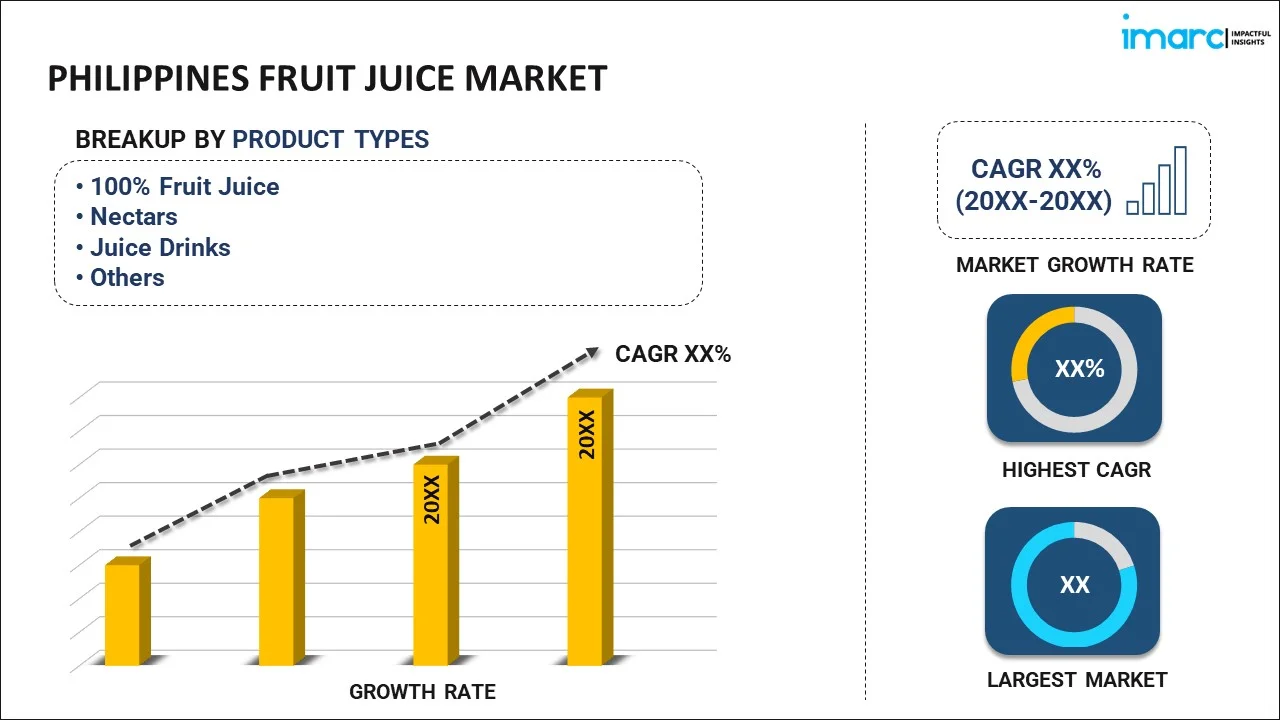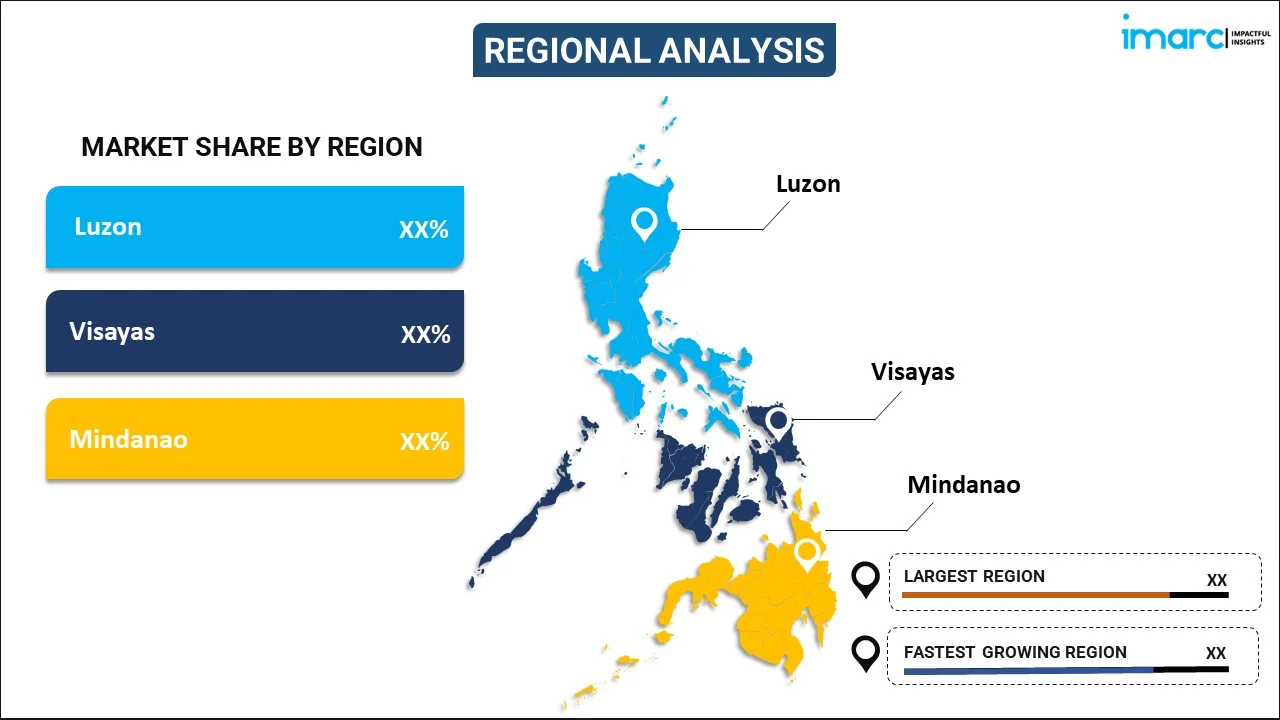
Philippines Fruit Juice Market Report by Product Type (100% Fruit Juice, Nectars, Juice Drinks, Concentrates, Powdered Juice, and Others), Flavor (Orange, Apple, Mango, Mixed Fruit, and Others), Distribution Channel (Supermarkets and Hypermarkets, Convenience Stores, Specialty Food Stores, Online Retail, and Others), and Region 2024-2032
Philippines Fruit Juice Market Overview:
The Philippines fruit juice market is projected to exhibit a growth rate (CAGR) of 5.20% during 2024-2032. The market is propelled by increasing health awareness and demand for natural products, inflating income levels and rising urbanization, and rapid expansion of retail channels and marketing efforts, stringent government initiatives and regulations, changing cultural and dietary preferences, and growing economic factors and price sensitivity.
|
Report Attribute
|
Key Statistics
|
|---|---|
|
Base Year
|
2023 |
|
Forecast Years
|
2024-2032
|
|
Historical Years
|
2018-2023
|
| Market Growth Rate (2024-2032) | 5.20% |
Philippines Fruit Juice Market Trends:
Rising Number of Individuals Opting for Natural or Organic Food Products
Health-conscious individuals are one of the major drivers of the fruit juice market in the Philippines. With the growing concerns about lifestyle illnesses and the importance of nutrition, individuals are looking for healthier and organic beverage options. According to the United Nations Children's Fund (UNICEF), after the sudden outbreak of the COVID-19 pandemic, the 78% of individuals in the Philippines region preferred organic food. Fruit juices, are considered as organic and nutritious, are being increasingly consumed as they provide a convenient way to consume vital vitamins and minerals. Additionally, the growing trend toward clean label products, free from artificial flavors and additives, further leads to a positive market outlook. Consequently, fruit juices branded as organic, natural, and free from inorganic materials are gaining popularity among health-conscious individuals across the region, who focus on wellness and nutrition while making their lifestyle choices. This underlines the importance for fruit juice key players to cater to the demand for healthier options and also to communicate the health benefits and purity of their products effectively to capitalize on this growing market segment.
Growing Disposable Income Levels and Rapid Urbanization
The increasing disposable income and urbanization in the Philippines are driving the demand for convenience foods and beverages, including fruit juices. According to the UNITED NATIONS (UN), the Philippines a rapidly urbanizing economy with 48% of its total population residing in the urban population in 2000 in comparison to 37% more than two decades ago. As more Filipinos migrate to urban areas and lead fast-paced lifestyles, there is a growing demand for on-the-go beverage options that are convenient and nutritious. This has led to a rise in the consumption of packaged fruit juices, particularly among the younger demographic and working professionals.
Rapidly expanding retail channels and Marketing Efforts
The expansion of retail channels and aggressive marketing efforts in the Philippines fruit juice market signifies a dynamic response to shifting consumer preferences and market trends. Beyond just increasing accessibility through diverse distribution channels, companies are deploying innovative marketing strategies tailored to capture the attention of the Filipino consumer base. Celebrity endorsements, for instance, play a significant role in influencing consumer purchasing decisions by associating the product with popular personalities. Product placements in key locations within supermarkets and convenience stores strategically position fruit juices for impulse purchases. Additionally, the advent of social media campaigns allows companies to engage directly with consumers, fostering brand loyalty and driving sales through interactive content and promotions. This multi-faceted approach to marketing expands the reach of fruit juice products and also creates a compelling narrative around health, convenience, and lifestyle, resonating with the diverse demographic of Filipino consumers.
Philippines Fruit Juice Market News:
- In December 2023, Coca-Cola Europacific Partners (CCEP) plans to invest $1 billion in the Philippines over the next five years to grow its business operations. CCEP currently has 9,000 direct employees in the Philippines, with another 100,000 spread throughout its distribution and supply chains. CCEP and Aboitiz Equity Ventures (AEV) announced plans to acquire all shares in Coca-Cola Beverages Philippines, with AEV holding a 40% stake and CCEP holding the remaining 60%.
Philippines Fruit Juice Market Segmentation:
IMARC Group provides an analysis of the key trends in each segment of the market, along with forecasts at the country level for 2024-2032. Our report has categorized the market based on product type, flavor, and distribution channel.
Product Type Insights:

- 100% Fruit Juice
- Nectars
- Juice Drinks
- Concentrates
- Powdered Juice
- Others
The report has provided a detailed breakup and analysis of the market based on the product type. This includes 100% fruit juice, nectars, juice drinks, concentrates, powdered juice, and others.
Flavor Insights:
- Orange
- Apple
- Mango
- Mixed Fruit
- Others
A detailed breakup and analysis of the market based on the flavor have also been provided in the report. This includes orange, apple, mango, mixed fruit, and others.
Distribution Channel Insights:
- Supermarkets and Hypermarkets
- Convenience Stores
- Specialty Food Stores
- Online Retail
- Others
The report has provided a detailed breakup and analysis of the market based on the distribution channel. This includes supermarkets and hypermarkets, convenience stores, specialty food stores, online retail, and others.
Regional Insights:

- Luzon
- Visayas
- Mindanao
The report has also provided a comprehensive analysis of all the major regional markets, which include Luzon, Visayas, and Mindanao.
Competitive Landscape:
The market research report has also provided a comprehensive analysis of the competitive landscape. Competitive analysis such as market structure, key player positioning, top winning strategies, competitive dashboard, and company evaluation quadrant has been covered in the report. Also, detailed profiles of all major companies have been provided.
Philippines Fruit Juice Market Report Coverage:
| Report Features | Details |
|---|---|
| Base Year of the Analysis | 2023 |
| Historical Period | 2018-2023 |
| Forecast Period | 2024-2032 |
| Units | Million US$ |
| Scope of the Report | Exploration of Historical and Forecast Trends, Industry Catalysts and Challenges, Segment-Wise Historical and Predictive Market Assessment:
|
| Product Types Covered | 100% Fruit Juice, Nectars, Juice Drinks, Concentrates, Powdered Juice, Others |
| Flavors Covered | Orange, Apple, Mango, Mixed Fruit, Others |
| Distribution Channels Covered | Supermarkets and Hypermarkets, Convenience Stores, Specialty Food Stores, Online Retail, Others |
| Regions Covered | Luzon, Visayas, Mindanao |
| Customization Scope | 10% Free Customization |
| Post-Sale Analyst Support | 10-12 Weeks |
| Delivery Format | PDF and Excel through Email (We can also provide the editable version of the report in PPT/Word format on special request) |
Key Questions Answered in This Report:
- How has the Philippines fruit juice market performed so far and how will it perform in the coming years?
- What has been the impact of COVID-19 on the Philippines fruit juice market?
- What is the breakup of the Philippines fruit juice market on the basis of product type?
- What is the breakup of the Philippines fruit juice market on the basis of flavor?
- What is the breakup of the Philippines fruit juice market on the basis of distribution channel?
- What are the various stages in the value chain of the Philippines fruit juice market?
- What are the key driving factors and challenges in the Philippines fruit juice?
- What is the structure of the Philippines fruit juice market and who are the key players?
- What is the degree of competition in the Philippines fruit juice market?
Key Benefits for Stakeholders:
- IMARC’s industry report offers a comprehensive quantitative analysis of various market segments, historical and current market trends, market forecasts, and dynamics of the Philippines fruit juice market from 2018-2032.
- The research report provides the latest information on the market drivers, challenges, and opportunities in the Philippines fruit juice market.
- Porter's five forces analysis assist stakeholders in assessing the impact of new entrants, competitive rivalry, supplier power, buyer power, and the threat of substitution. It helps stakeholders to analyze the level of competition within the Philippines fruit juice industry and its attractiveness.
- Competitive landscape allows stakeholders to understand their competitive environment and provides an insight into the current positions of key players in the market.
Need more help?
- Speak to our experienced analysts for insights on the current market scenarios.
- Include additional segments and countries to customize the report as per your requirement.
- Gain an unparalleled competitive advantage in your domain by understanding how to utilize the report and positively impacting your operations and revenue.
- For further assistance, please connect with our analysts.
 Inquire Before Buying
Inquire Before Buying
 Speak to an Analyst
Speak to an Analyst
 Request Brochure
Request Brochure
 Request Customization
Request Customization




.webp)




.webp)












